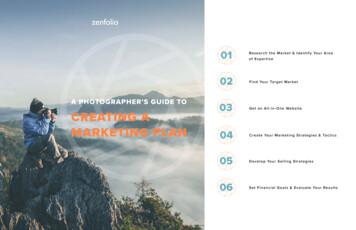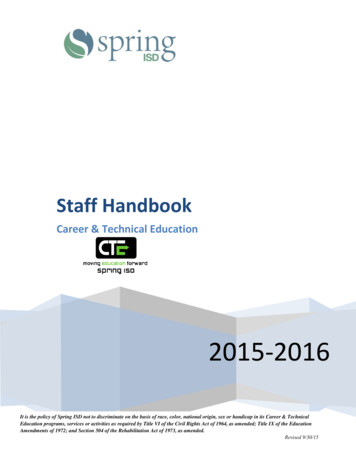CTE Standards Unpacking Photography II
CTE Standards UnpackingPhotography IICourse: Photography IICourse Description: Photography II provides the advanced photography student withpractical knowledge and highly advanced skills for a comprehensive career inphotography. Students will explore advanced lighting and editing techniques and thecommercial distribution of photographic works.Career Cluster: Arts, A/V Technology, CommunicationsPrerequisites: Photography IProgram of Study Application: Photography II is a Level III course in the Arts, A/VTechnology, Communications career cluster, Printing Technology, Journalism &Broadcasting; Telecommunications/A-V Technology and Film; or Visual Arts pathways.Photography I is a prerequisite for this course. Completion of Photography II wouldprepare a student to successfully participate in a level IV course or capstone experience.INDICATOR #P2 1: Explore opportunities in commercial photographySUB-INDICATOR 1.1 (Webb Level: 4 Extended Thinking): Plan for employment andentrepreneurial endeavors in commercial photographySUB-INDICATOR 1.2 (Webb Level: 2 Skill/Concept): Demonstrate interpersonalskills essential to workplace successSUB-INDICATOR 1.3 (Webb Level: 1 Recall): Identify basic resources commonlyused in the photography industryKnowledge (Factual):Understand (Conceptual): Do (Application):-Employment-A variety of employment-Explore employmentrequirements & skillsand entrepreneurialand entrepreneurialendeavors exist inopportunities in-Types of commercialcommercial photographycommercial photographyphotography-Practice interpersonal-Effect interpersonal skills-Basic equipment & tools on employee/clientskills necessary in theused in commercialworkplacerelationshipsphotography-Use of resources in theindustry
Benchmarks:Students will be assessed on their ability to: Explore professional organizations and create a chart of the roles, benefitsand resources available Create an employment portfolio for use in applying for internships andwork-based learning opportunities Interview a professional photographer regarding interpersonal skillsrequired for the position List resources used in a specific area of commercial photography.Academic ConnectionsELA Literacy and/or Math StandardSample Performance Task Aligned to(if applicable, Science and/or Socialthe Academic Standard(s):Studies Standard):9-10.W.2 – Writeinformative/explanatory texts toexamine and convey complex ideas,concepts, and information clearly andaccurately through the effectiveselection, organization, and analysis ofcontent.-Write an entrepreneurial business planfor a commercial photography business.INDICATOR #P2 2: Exhibit legal and ethical conductSUB-INDICATOR 2.1 (Webb Level: 3 Strategic Thinking): Evaluate professionalcodes of conductSUB-INDICATOR 2.2 (Webb Level: 2 Skill/Concept): Demonstrate personalprofessionalism related to commercial photographyKnowledge (Factual):Understand (Conceptual): Do (Application):-Professional codes of-Application of professional -Research codes ofconductcodes of ethics in guidingprofessional conductprofessional behavior-Practice professionalismBenchmarks:Students will be assessed on their ability to: Write an evaluation of a professional code of conduct. Demonstrate professionalism in photography through role play.
Academic ConnectionsELA Literacy and/or Math StandardSample Performance Task Aligned to(if applicable, Science and/or Socialthe Academic Standard(s):Studies Standard):9-10.W.1 - Write arguments to supportclaims in an analysis of substantivetopics or texts, using valid reasoning andrelevant and sufficient evidence.-Compare and contrast professional andunprofessional behaviors related tocommercial photography.INDICATOR #P2 3: Evaluate photographic techniquesSUB-INDICATOR 3.1 (Webb Level: 4 Extended Thinking): Analyze how thecombination of camera settings and desired aesthetics influence the creation of aphotographSUB-INDICATOR 3.2 (Webb Level: 3 Strategic Thinking): Evaluate how cameraaccessories are used to produce commercial photographySUB-INDICATOR 3.3 (Webb Level: 2 Skill/Concept): Demonstrate proficiency inusing advanced lighting techniquesKnowledge (Factual):Understand (Conceptual): Do (Application):-Cameras setting-Effect of camera setting-Create variouscombinations (I.e.combinations in taking acombinations of cameraaperture, shutter, ISO)photographsettings for desiredeffects-Commercial camera-Use of commercial cameraaccessoriesaccessories-Investigate how cameraaccessories are used-Lighting techniques-Effect of lightingtechniques on a photograph -Practice using advancedlighting techniquesBenchmarks:Students will be assessed on their ability to: Compose photographs using a variety of camera setting combinations. Analyze the effectiveness of the camera settings in creating photograph(s). Cite evidence for specific camera accessories to be used in commercialphotography. Compare photographs for lighting techniques used.
Academic ConnectionsELA Literacy and/or Math StandardSample Performance Task Aligned to(if applicable, Science and/or Socialthe Academic Standard(s):Studies Standard):CCRA.SL.5 - Make strategic use of digitalmedia and visual displays of data toexpress information and enhanceunderstanding of presentations.-Student will evaluate the lightingtechnique(s) and the specific cameraaccessories needed and presentinformation to a perspective client.INDICATOR #P2 4: Evaluate photographs for effective compositionSUB-INDICATOR 4.1 (Webb Level: 4 Extended Thinking): Apply professionalaesthetics to compositional elements in photographsSUB-INDICATOR 4.2 (Webb Level: 4 Extended Thinking): Critique photographs toa professional standardKnowledge (Factual):Understand (Conceptual): Do (Application):-Professional aesthetics-Differences between client -Defend compositionalwants and photographerelements to create-Elements of composition wantsaesthetically pleasingin photographyphotographs-Effects of professional-Professional standardsstandards on job success-Evaluate photographsfor professional use.Benchmarks:Students will be assessed on their ability to: Develop checklists for assessing the elements of composition in people, placeand nature photography After interviewing a prospective client, create images using professionalstandards and composition to meet client needs.Academic ConnectionsELA Literacy and/or Math StandardSample Performance Task Aligned to(if applicable, Science and/or Socialthe Academic Standard(s):Studies Standard):9-12. ET.CT.2 - Students demonstratethe design process through problemsolving.-Students will interview a client andphoto an event using the client'srequirements.
INDICATOR #P2 5: Create commercial photographic productsSUB-INDICATOR 5.1 (Webb Level: 3 Strategic Thinking): Demonstrate advancedproficiency in digital darkroom softwareSUB-INDICATOR 5.2 (Webb Level: 3 Strategic Thinking): Demonstrate use ofevaluation techniques for professional portfoliosKnowledge (Factual):Understand (Conceptual): Do (Application):-Advanced techniques in -Applications of software in -Revise photographsDigital darkroomusing advancedthe creation of commercialsoftwaretechniquesphotographic products-Components ofprofessional portfolios-Effects of evaluationprocesses on portfolioreviews-Evaluate a professionalportfolioBenchmarks:Students will be assessed on their ability to: Prepare a professional portfolio and evaluate using established criteria. Assess a professional portfolio and cite relevant feedback.Academic ConnectionsELA Literacy and/or Math StandardSample Performance Task Aligned to(if applicable, Science and/or Socialthe Academic Standard(s):Studies Standard):9. ET.CT.3 -Students evaluate and selecttechnology tools based on the specifictasks-Evaluate photographs and use darkroom techniques to improve thephotographs.Additional ResourcesDigital Photography rcial Photography Careershttp://study.com/articles/Commercial Photographer Employment Information and Requirements for a Career in Commercial Photo.htmlASMP Code of code-ethics/Advanced Lighting 88Camera 888
Photography luate-your-photo/Photography Portfolio remarkable-photographers-portfolios/Steps to creating a photography e-proud-of--photo-3991Portfolio 013/08/Develop-Evaluation-PortfolioSESEA.pdf
Photography II Course: Photography II Course Description: Photography II provides the advanced photography student with practical knowledge and highly advanced skills for a comprehensive career in photography. Students will explore advanced lighting and editing techniques and the commercial distribution of photographic works.
12 Summer Data -410 CTE Attendance: * Collected only in the summer submission. * 410 Attendance requires the student has a valid CTE Indicator code on the 101 record. * Each student enrolled for more than two hours in a valid CTE course must have a 410 record. * "V" Codes: * V1 45-89 ave. minutes per day in a CTE course * V2 90-149 ave. minutes per day in a CTE course
Photography 2. Portrait 3. Boudoir Photography 4. Wedding Photography 5. Newborn Photography 6. Landscape Photography 7. Photojournalism 8. Street Photography 9. Food Photography 10. Candid Photography SEARCH WORDS 10 TOP PHOTOGRAPHY WEB
1. Sony World Photography Awards 2. Fine Art Photography Awards 3. National Geographic Photography Competitions 4. Monochrome Photography Awards 5. International Photography Grant 6. Neutral Density Photography Awards 7. Nikon International Small World Photo Contest 8. ZEISS Photography Award 9. Chromatic Color Photography Awards 10. iPhone .
CTE standards and 13 states and two territories have state-approved postsecondary standards. Only two states and one territory have CTE standards that are fully aligned between secondary and postsecondary systems. X The majority of states have the authority to adopt both secondary and postsecondary CTE standards, although most
New York State Work Experience Requirements by CTE Title SECTION C. BECOMING A CTE TEACHER C1. CTE Resume Example C2. The CTE Hiring Process C3. Applying for Salary Increase SECTION D. APPLYING FOR A CTE TEACHING CERTIFICATION D1. Steps to Applying for a Trans-A Certificate with NYSED D2. Trans-A Requirements for All NYS Teacher Applicants D3.
CTE Overview 3 CTE Department Contacts 4 Career Pathways 2015-2016 5 CTE Course List 2015-2016 6 CTE Curriculum & Resources 8 Professional Development Requirements 9 CTE Advisory Board 14 Career Cluster Coordinator Guidelines 15 Career & Technical Student Organizations (CTSOs) & Sponsorship 18 Certification Reporting 23
Virginia includes CTE courses within 16 career clusters, each with multiple pathways designed by the school divisions. For example, the Health Science career cluster may include pathways for therapeutic services, biotechnology, or diagnostic services. CTE credential. A CTE credential certifies that a student has mastered specific CTE content.
c. Describe the major events of the American Revolution and explain the factors leading to American victory and British defeat; include the Battles of Lexington and Concord, Saratoga, and Yorktown. d. Describe key individuals in the American Revolution with emphasis on King George III, George Washington, Benjamin Franklin, Thomas Jefferson, Benedict Arnold, Patrick Henry, and John Adams .























